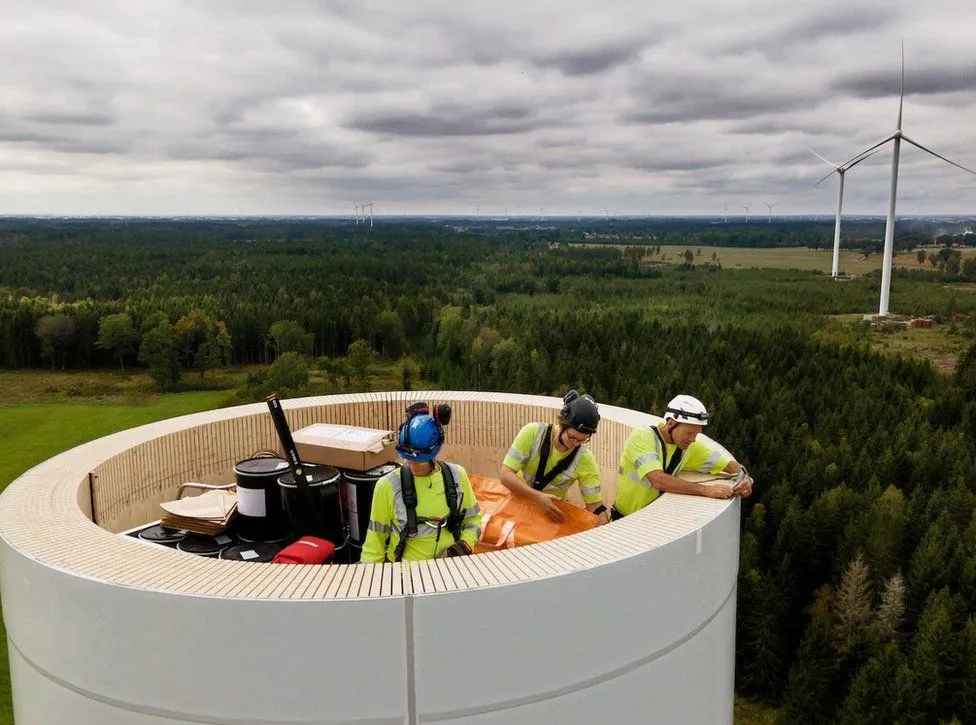- 33 Posts
- 196 Comments

 1·5 days ago
1·5 days agoWould the materials have much more of a footprint than geothermal installations? Because that slight 7° difference between below ground temp and above ground temps apparently justifies the labor, materials, and power to the circulators for harvesting geothermal energy. So this seems to be the same but adding a cherry on top – incorporating a heat pump to add to the energy of a geothermal system.

 2·4 days ago
2·4 days agoBecause of Google’s DoS attack, those of us in the open free world cannot reach Youtube. So would someone please explain the concept in text?
Is this it? → https://utahforge.com/2022/12/30/did-you-know-that-scottish-clubbers-use-dance-beat-to-generate-heat/
Seems like a great idea. Like using the body heat to boost geothermals.
Someone plz tell Massive Attack about this. Massive Attack has gone gung-ho on eco-friendly festivals (in places inaccessible by car). They might want to throw some indoor events with this tech.
(edit) from the article:
“An experienced DJ could get up to 600 watts with the right song at the right time.”
So IIUC that’s like ~1½ solar panels getting a full dose of UV, correct? I guess that’s not much. But nonetheless not something to throw away either. So during the day solar panels on the roof could heat the ground pipes and during the night the clubbers keep the system powered.
Would be fun for that power output to be measured, and then that power measurement could be a performance index on each DJ. You pay the DJ according to the power output they can produce. Though I guess that would screw over the ambiant / trip-hop DJs.

 24·20 days ago
24·20 days agoHave they thought this through? To install batteries that are much heavier than what the bus trip requires makes the bus less efficient. Research in the UK found that a bus carrying 5 people is about as efficient as 5 cars each carrying 1 person. That’s because of the weight of the bus. So the goal should be to fill the bus with people, not excessive batteries and overhead that need not move back and forth from A to B which then requires more riders to maintain the same efficiency.
Sure they need to store energy for to smooth out peak grid consumption but probably smarter to do that with stationary batteries – if they must use batteries. Another way to store energy: pump water to the top of a mountain and open a dam that turns a hydro turbine when they need the energy back.
from the article:
Pollution from buses and other vehicles contributes to chronic asthma among students, which leads to chronic absenteeism.
Seems like a stretch. Even if they can attribute chronic absenteeism to air pollution and keep a straight face, moving the pollution of a fleet of buses that makes 2 trips/day from the street to the power plant isn’t going to change the absenteeism by reducing asthma. This claim only signals a bit of desperation to get support.

 1·1 month ago
1·1 month agoThe nationwide fuckup in the US is zoning rules that block commercial venues from residential regions, which means people cannot step outside their front door and get groceries in a 1 block walk. People are forced to travel unwalkable distances to reach anything, like food and employment. Which puts everyone in a car. Which means huge amounts of space is needed for wide roads and extensive car parking, generally big asphalt lots, which exacerbates the problem because even more space is wasted which requires everything to be spread out even more, putting resources out of the reach of cyclists. Making the city mostly concrete and asphalt also means water draining problems where less of it makes it into the soil and groundwater, and it means the city temp is higher because of less evaporative cooling from the land mass (Arizona in particular).
This foolishness is all done for pleasant window views, so everyone can have a view of neighbors gardens instead of a shop front.
Europe demonstrates smarter zoning, where you often have a shop on the ground level and housing above it. You don’t need a car because everything is in walking or cycling distance. But you more likely have an unpleasant view.

 1·1 month ago
1·1 month agoWell that depends on how equipped you are. One cool thing about compressors is you can straight up connect a PV directly to a compressor with no voltage regulators or anything. So if you have a simple setup like that, I can see up front cost effectiveness in storing ice. But if you already have batteries, and thus voltage regulators and all the costly intermediate components to make that possible, then I would agree… I might rather store it in lead acid batteries as that would be more versatile.

 1·1 month ago
1·1 month agoSounds like they would do well in Arizona, where the air is dry. IIUC swamp coolers were very popular in Arizona until ~20 years ago when temps increased so much that swamp coolers could not make enough difference (this is largely because more and more land became concrete, which reduced the effect of evaporative cooling the land mass). So a/c became more popular in AZ IIUC. But the dry air would still be dry.

 3·1 month ago
3·1 month agoGreat basic concept but I think I would benefit more for the stored cooling going toward ice cubes for mojitos.
I don’t imagine that a single family dwelling would benefit from the extra complexity of adding cold water pipes in all the floors of the house. Probably makes more sense for apartment buildings (or perhaps homes that already have hydrothermal floors for heating).

 1·1 month ago
1·1 month agoConsider this excerpt:
When the grid is extremely stressed, utility companies are sometimes forced to shut off electricity supply to some areas, leaving people there without power when they need it most. Technologies that can adjust to meet the grid’s needs could help reduce reliance on these rolling blackouts.
So grid-powered a/c can give the grid relief at peak times with this tech.
But indeed this tech on a PV-powered compressor seems sketchy. There are probably moments when the sun is hitting hard but the temp has not climbed up yet (sunrise) in which case it would be useful to store the energy. But I’m struggling to understand how the complexity of the system would be justified considering the overall efficiency is reduced as well. I wonder what proportion of time this system would be working in storage mode. If sunrise is 9am and peak heat is 2pm, maybe there’s ~2—4 hours of storage time potential.
OTOH, consider someone with a slightly underpowered PV. Maybe the energy storage can compensate for peak heat times when the PV output may be insufficient. Perhaps it would enable homeowners to spend less on PV panels.

 1·1 month ago
1·1 month agoBy size, you are referring more specifically to area. Area while neglecting population is inversely proportional to population density¹. But even apart from that – how does that support the claim that it’s sensible to disregard cities and just look per capita nationwide? NYC should be compared as a single whole city against other cities of comparable population density. Area does not matter as an independent variable on its own. What would the point be to blur NYC into a nationwide track per capita?
BTW, NYC has a subway system. I’ve used it a few times and it was not even close to being overcrowded but maybe I had lucky timing. Are you saying more track is needed there?
¹ population density: heads per m²

 53·1 month ago
53·1 month agoSubways are pretty much exclusively built in the cities
Not just any city. Dense cities. Cities that are so densely populated that it would be /impossible/ for every person to move around in a car. Countless US cities are not even close to crossing that threshold. It just makes no sense to look at nationwide per capita on this. Only a city by city comparison of like with like population density is sensible.
(edit)
There is a baby elephant in the room that needs mention: US cities are designed with shitty zoning plans. They are designed so that each person on avg needs to travel more distance per commute to accomplish the same tasks (work and groceries). This heightens the congestion per capita. So ideally we would calculate daily net commute distance needed per capita plotted against subway track per capita for cities of comparable people per m². Which would embarrass US city mayors even more.

 132·1 month ago
132·1 month agoFrom the article:
See the U.S. flatlining in transit miles per capita
A devil’s advocate would rightfully argue that that’s expected given the much lower average population density of the US – the same factor that made it a struggle to get broadband Internet to everyone in the US. Bizarre to use a nationwide per capita as a basis for mass transit comparisons. It should be a city-by-city comparison that groups cities by comparable population density. US cities would likely still come out behind and embarrassed, but more accurately so.
Consider the marketing angle – instead of saying “the US is losing” (which diffuses responsibility and makes plenty of room for finger-pointing), instead say “@conditional_soup@lemm.ee’s city lost its ass in the bi-annual city infra competency competition”. Then that mayor has some direct embarrassment to pressure action.
fwiw, here is an emacs version:
https://codeberg.org/martianh/lem.el#headline-11
I think what would be most useful would be a usenet→lemmy gateway, so that rich catalog of usenet clients can be leveraged on Lemmy.

 1·2 months ago
1·2 months agoI get rid of them pretty quickly by saying I have no bank account. I might start adding to that “take cryptocurrency?” so they leave with the idea that maybe they should be open to cryptocurrency.

 1·2 months ago
1·2 months ago@youmaynotknow is spot on. But consider this a very basic primer on just a small fraction of privacy abuse by banks:
So there’s 22 privacy abuses by banks to get you started. And that just barely scratches the surface.
You can somewhat ignore paragraphs 15 and 23 in terms of privacy. OTOH privacy is hand-in-hand with control and paragraphs 15 & 23 reflect control being in the wrong hands.

 1·2 months ago
1·2 months agoBanks abuse our privacy in countless ways. This could fill a book. This policy amounts to forced banking. I boycott banks. Banks have us by the balls and they abuse that power. A bank recently told me (in effect) to fuck off if I don’t have a mobile phone number to give them.

 1·2 months ago
1·2 months agoIt’s impossible to define the amount in relative terms such as “average EU monthly salary +25%”,
It’s not impossible. Indexes are published. This is what they do with rent in places where rent is controlled. Landlords cannot increase rent more than an index. So they have to do the math. And in this case it’s not even a variable baseline like rent, it’s fixed, so the calculation can also be published so people need not do any math.

 1·2 months ago
1·2 months agoThat’s net (take-home pay), not gross. Tax is high enough that you need to double that figure (€4,400) to get the gross pay. And just wait till you account for inflation, which the EU cash limits apparently fail to account for.

 3·2 months ago
3·2 months agothis poll shows it’s non-partisan:
https://layer8.space/@hyakinthos/112554837920009346
The left respects privacy far more than the right. But the left also has that high-taxation tendency. The outcome of that tug-of-war within left-leaning people results in ~73% embracing cash – just like the conservatives who don’t give a shit about privacy but have contempt for tax.













Shit… sounds about right.
Although the /water is hot enough/ scenario could be addressed mechanically: bigger water tank, lower heating element raised and the heat pump heating the bottom exclusively where it could /always/ add heat because it would never be hot enough at the bottom.
(edit) after some thought, it would superficially make sense to get a factory water heater (tank) and not tamper with it at all. Just have a PV-powered HP heat water before it enters the stock water heater (in a tank or coil). Thus there could be 2 heat pumps (but for economy the stock tank would just be a simple non-heat pump type thus 1 HP). I guess this is still a dead idea anyway if it’s true that a PV cannot simply directly connect to a compressor.